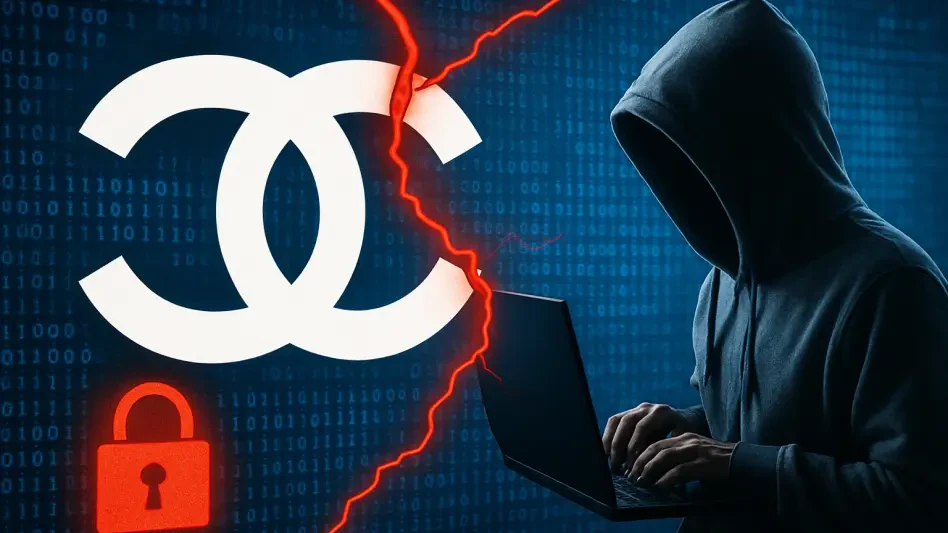Imagine a luxury fashion titan like Chanel, synonymous with elegance and exclusivity, falling prey to a cyberattack that exposes sensitive customer data, sending shockwaves through the corporate world. On July 25, a breach in a Salesforce-hosted US database compromised names, email addresses, and other personal information of Chanel’s clients. This incident, orchestrated by the notorious ShinyHunters group, has raised urgent questions about cybersecurity in cloud environments. This roundup gathers diverse opinions and actionable tips from industry experts to dissect the attack, explore its implications, and offer strategies to safeguard against similar threats. The goal is to provide a comprehensive view of this evolving challenge and equip businesses with practical insights to bolster their defenses.
Unpacking the Breach: What Happened and Why It Matters
The Chanel data breach revealed a stark vulnerability in even the most prestigious brands. Attackers infiltrated a third-party service within Chanel’s Salesforce ecosystem, accessing limited but critical customer information. Unlike traditional hacks exploiting software flaws, this incident relied on social engineering tactics, specifically vishing (voice phishing), to trick employees into granting access. Industry observers note that such methods highlight a dangerous gap in corporate security, where human error often becomes the weakest link. The significance of this event lies not just in the breach itself but in its reflection of a broader trend targeting elite companies.
Beyond Chanel, the attack underscores a systemic issue for businesses relying on cloud platforms. Cybersecurity professionals emphasize that while the technology may be robust, the human element remains susceptible to manipulation. This incident serves as a wake-up call for organizations to reassess how they protect sensitive data in shared digital environments. Discussions among experts reveal a consensus that breaches like this damage customer trust and brand reputation, often with long-lasting consequences. The focus now shifts to understanding the tactics used and how they fit into a larger pattern of cybercrime.
ShinyHunters’ Tactics: Expert Opinions on Social Engineering
Vishing as a Primary Weapon
ShinyHunters’ approach to the Chanel breach relied heavily on vishing, a form of voice phishing that manipulates individuals over the phone to divulge credentials or install malicious applications. Cybersecurity analysts describe this tactic as particularly insidious because it bypasses technical defenses by exploiting human psychology. Many experts agree that the group’s repeated success with this method—seen in prior attacks on other major brands—demonstrates a sophisticated understanding of organizational behavior. The challenge lies in countering a threat that doesn’t target code but rather trust and naivety.
Differing views emerge on how to address such non-technical attacks. Some industry voices advocate for advanced AI tools to detect suspicious communication patterns, while others argue that technology alone cannot solve a fundamentally human problem. A recurring theme in these discussions is the need for a cultural shift within companies to prioritize skepticism and verification over blind compliance. The Chanel incident illustrates how even a single lapse in judgment can open the door to significant data theft, prompting a reevaluation of current security protocols.
Comparing Perspectives on Defense Strategies
Contrasting opinions also surface regarding the balance between prevention and response. Certain security consultants suggest that proactive measures, such as simulated phishing exercises, are critical to prepare staff for real-world scenarios. Others, however, point out that rapid response mechanisms are equally vital, as breaches are often inevitable in today’s threat landscape. Both sides acknowledge that ShinyHunters’ ability to exploit human vulnerabilities reveals a gap in many corporate defenses, urging a dual focus on education and incident management. This diversity of thought highlights the complexity of tackling social engineering.
Patterns of Vulnerability: Luxury Brands and Cloud Platforms
A Recurring Target for Cybercriminals
Chanel is not an isolated case in the crosshairs of ShinyHunters. Experts note that luxury brands like Adidas and subsidiaries of LVMH, including Louis Vuitton and Dior, have also suffered similar breaches through Salesforce environments. This pattern suggests that high-profile companies with valuable customer data are prime targets for cybercriminals seeking financial gain or reputational leverage. Industry analyses point to the allure of luxury brands as symbols of wealth, making their databases especially lucrative for extortion or black-market sales.
The shared use of cloud platforms like Salesforce emerges as a common thread in these attacks. While some specialists argue that centralized systems create efficiencies for businesses, others warn that they also present a single point of failure for attackers to exploit. The debate centers on whether the benefits of cloud infrastructure outweigh the risks of interconnected vulnerabilities. These incidents collectively erode consumer confidence, as clients of elite brands expect ironclad protection of their personal information, not exposure to cyber risks.
Risks of Shared Infrastructure
Another angle of discussion focuses on the inherent dangers of third-party integrations within cloud systems. Many cybersecurity professionals caution that insufficient vetting of external services can create backdoors for attackers, as seen in the Chanel breach. Recommendations often include stricter audits and transparency requirements for third-party providers to minimize these risks. The consensus is that while cloud platforms offer scalability, they also demand heightened vigilance to prevent a domino effect of breaches across multiple organizations.
Salesforce’s Stance and Industry Reactions
Platform Security Versus User Responsibility
Salesforce has maintained that its core systems remain uncompromised in the Chanel incident, attributing the breach to social engineering rather than technical flaws. This position has sparked varied reactions among industry watchers. Some agree with the company’s emphasis on user responsibility, arguing that organizations must enforce stricter access controls and employee oversight. This perspective places the onus on businesses to adapt their practices to the realities of modern cyber threats, rather than relying solely on platform providers.
Others, however, express concern over what they see as a deflection of accountability. Critics suggest that cloud providers should play a more active role in guiding users toward best practices, possibly through mandatory security features or enhanced monitoring tools. The divide in opinion reflects a broader tension in the industry about where the burden of cybersecurity truly lies. As attacks grow more sophisticated, this debate continues to shape expectations for both technology vendors and their clients.
Calls for Enhanced Governance
Amid these discussions, there is a growing push for tighter governance in cloud ecosystems. Industry leaders advocate for comprehensive audits of third-party integrations and more robust access management protocols to prevent unauthorized entry. Some propose that platform providers and businesses collaborate on standardized security frameworks to address common vulnerabilities. This collaborative approach aims to bridge the gap between technological safeguards and human preparedness, offering a potential path forward in an increasingly complex threat environment.
Key Takeaways and Tips from the Cybersecurity Community
Synthesizing the insights from various experts, several actionable strategies emerge to combat social engineering threats like those employed by ShinyHunters. A primary recommendation is rigorous employee training focused on recognizing and resisting phishing attempts, including vishing scenarios. Simulated attacks can help staff develop practical skills to identify suspicious interactions, reducing the likelihood of falling victim to deception.
Additionally, strengthening access controls stands out as a critical measure. Multi-factor authentication and regular reviews of user permissions are frequently cited as essential steps to limit unauthorized access. Experts also stress the importance of auditing third-party connections to ensure no weak links exist in the security chain. These combined efforts aim to create multiple layers of defense against both technical and human-centric attacks.
Finally, fostering a culture of cybersecurity awareness within organizations is seen as a long-term solution. Encouraging employees to question unexpected requests and report anomalies can significantly bolster a company’s resilience. The collective wisdom from the industry underscores that while technology plays a role, the human factor remains paramount in preventing breaches. Businesses are urged to integrate these practices into their daily operations to stay ahead of evolving threats.
Reflecting on the Insights and Next Steps
Looking back, the Chanel data breach orchestrated by ShinyHunters sparked intense discussions among cybersecurity experts about the vulnerabilities exposed through social engineering. The varied opinions highlighted a critical divide between technological solutions and human preparedness, with many advocating for a balanced approach. Industry reactions to Salesforce’s stance also revealed a complex dynamic of accountability that shaped the narrative around cloud security.
Moving forward, businesses should prioritize integrating robust employee training programs to counter vishing and similar tactics. Adopting stricter access controls and conducting regular audits of third-party services emerged as vital steps to mitigate risks. Additionally, fostering partnerships between cloud providers and organizations could lead to innovative frameworks that address shared vulnerabilities. These actionable measures provide a roadmap for companies to strengthen their defenses and adapt to the ever-changing landscape of cyber threats.








